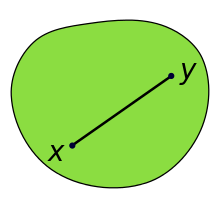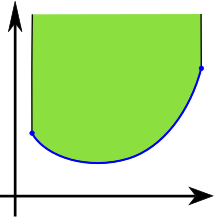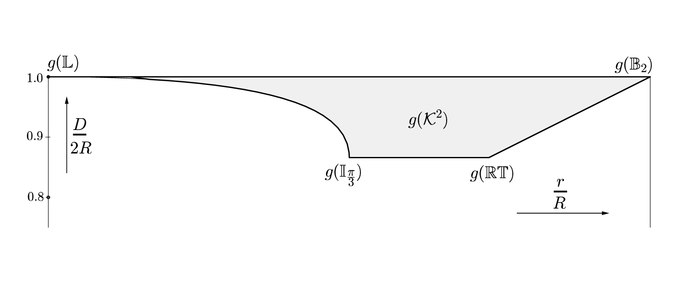Convex set


In geometry, a subset of a Euclidean space, or more generally an affine space over the reals, is convex if, given any two points in the subset, the subset contains the whole line segment that joins them. Equivalently, a convex set or a convex region is a subset that intersects every line into a single line segment (possibly empty).[1][2] For example, a solid cube is a convex set, but anything that is hollow or has an indent, for example, a crescent shape, is not convex.
The boundary of a convex set in the plane is always a convex curve. The intersection of all the convex sets that contain a given subset A of Euclidean space is called the convex hull of A. It is the smallest convex set containing A.
A convex function is a real-valued function defined on an interval with the property that its epigraph (the set of points on or above the graph of the function) is a convex set. Convex minimization is a subfield of optimization that studies the problem of minimizing convex functions over convex sets. The branch of mathematics devoted to the study of properties of convex sets and convex functions is called convex analysis.
The notion of a convex set can be generalized as described below.
Definitions[edit]

Let S be a vector space or an affine space over the real numbers, or, more generally, over some ordered field (this includes Euclidean spaces, which are affine spaces). A subset C of S is convex if, for all x and y in C, the line segment connecting x and y is included in C.
This means that the affine combination (1 − t)x + ty belongs to C for all x,y in C and t in the interval [0, 1]. This implies that convexity is invariant under affine transformations. Further, it implies that a convex set in a real or complex topological vector space is path-connected (and therefore also connected).
A set C is strictly convex if every point on the line segment connecting x and y other than the endpoints is inside the topological interior of C. A closed convex subset is strictly convex if and only if every one of its boundary points is an extreme point.[3]
A set C is absolutely convex if it is convex and balanced.
Examples[edit]
The convex subsets of R (the set of real numbers) are the intervals and the points of R. Some examples of convex subsets of the Euclidean plane are solid regular polygons, solid triangles, and intersections of solid triangles. Some examples of convex subsets of a Euclidean 3-dimensional space are the Archimedean solids and the Platonic solids. The Kepler-Poinsot polyhedra are examples of non-convex sets.
Non-convex set[edit]
A set that is not convex is called a non-convex set. A polygon that is not a convex polygon is sometimes called a concave polygon,[4] and some sources more generally use the term concave set to mean a non-convex set,[5] but most authorities prohibit this usage.[6][7]
The complement of a convex set, such as the epigraph of a concave function, is sometimes called a reverse convex set, especially in the context of mathematical optimization.[8]
Properties[edit]
Given r points u1, ..., ur in a convex set S, and r nonnegative numbers λ1, ..., λr such that λ1 + ... + λr = 1, the affine combination
Such an affine combination is called a convex combination of u1, ..., ur.
Intersections and unions[edit]
The collection of convex subsets of a vector space, an affine space, or a Euclidean space has the following properties:[9][10]
- The empty set and the whole space are convex.
- The intersection of any collection of convex sets is convex.
- The union of a sequence of convex sets is convex, if they form a non-decreasing chain for inclusion. For this property, the restriction to chains is important, as the union of two convex sets need not be convex.
Closed convex sets[edit]
Closed convex sets are convex sets that contain all their limit points. They can be characterised as the intersections of closed half-spaces (sets of point in space that lie on and to one side of a hyperplane).
From what has just been said, it is clear that such intersections are convex, and they will also be closed sets. To prove the converse, i.e., every closed convex set may be represented as such intersection, one needs the supporting hyperplane theorem in the form that for a given closed convex set C and point P outside it, there is a closed half-space H that contains C and not P. The supporting hyperplane theorem is a special case of the Hahn–Banach theorem of functional analysis.
Convex sets and rectangles[edit]
Let C be a convex body in the plane (a convex set whose interior is non-empty). We can inscribe a rectangle r in C such that a homothetic copy R of r is circumscribed about C. The positive homothety ratio is at most 2 and:[11]
Blaschke-Santaló diagrams[edit]
The set of all planar convex bodies can be parameterized in terms of the convex body diameter D, its inradius r (the biggest circle contained in the convex body) and its circumradius R (the smallest circle containing the convex body). In fact, this set can be described by the set of inequalities given by[12][13]

Alternatively, the set can also be parametrized by its width (the smallest distance between any two different parallel support hyperplanes), perimeter and area.[12][13]
Other properties[edit]
Let X be a topological vector space and be convex.
- and are both convex (i.e. the closure and interior of convex sets are convex).
- If and then (where ).
- If then:
- , and
- , where is the algebraic interior of C.
Convex hulls and Minkowski sums[edit]
Convex hulls[edit]
Every subset A of the vector space is contained within a smallest convex set (called the convex hull of A), namely the intersection of all convex sets containing A. The convex-hull operator Conv() has the characteristic properties of a hull operator:
- extensive: S ⊆ Conv(S),
- non-decreasing: S ⊆ T implies that Conv(S) ⊆ Conv(T), and
- idempotent: Conv(Conv(S)) = Conv(S).
The convex-hull operation is needed for the set of convex sets to form a lattice, in which the "join" operation is the convex hull of the union of two convex sets
Minkowski addition[edit]
![Three squares are shown in the nonnegative quadrant of the Cartesian plane. The square Q1 = [0, 1] × [0, 1] is green. The square Q2 = [1, 2] × [1, 2] is brown, and it sits inside the turquoise square Q1+Q2=[1,3]×[1,3].](http://upload.wikimedia.org/wikipedia/commons/thumb/3/3e/Minkowski_sum_graph_-_vector_version.svg/220px-Minkowski_sum_graph_-_vector_version.svg.png)
In a real vector-space, the Minkowski sum of two (non-empty) sets, S1 and S2, is defined to be the set S1 + S2 formed by the addition of vectors element-wise from the summand-sets
For Minkowski addition, the zero set {0} containing only the zero vector 0 has special importance: For every non-empty subset S of a vector space
Convex hulls of Minkowski sums[edit]
Minkowski addition behaves well with respect to the operation of taking convex hulls, as shown by the following proposition:
Let S1, S2 be subsets of a real vector-space, the convex hull of their Minkowski sum is the Minkowski sum of their convex hulls
This result holds more generally for each finite collection of non-empty sets:
In mathematical terminology, the operations of Minkowski summation and of forming convex hulls are commuting operations.[15][16]
Minkowski sums of convex sets[edit]
The Minkowski sum of two compact convex sets is compact. The sum of a compact convex set and a closed convex set is closed.[17]
The following famous theorem, proved by Dieudonné in 1966, gives a sufficient condition for the difference of two closed convex subsets to be closed.[18] It uses the concept of a recession cone of a non-empty convex subset S, defined as:
Theorem (Dieudonné). Let A and B be non-empty, closed, and convex subsets of a locally convex topological vector space such that is a linear subspace. If A or B is locally compact then A − B is closed.
Generalizations and extensions for convexity[edit]
The notion of convexity in the Euclidean space may be generalized by modifying the definition in some or other aspects. The common name "generalized convexity" is used, because the resulting objects retain certain properties of convex sets.
Star-convex (star-shaped) sets[edit]
Let C be a set in a real or complex vector space. C is star convex (star-shaped) if there exists an x0 in C such that the line segment from x0 to any point y in C is contained in C. Hence a non-empty convex set is always star-convex but a star-convex set is not always convex.
Orthogonal convexity[edit]
An example of generalized convexity is orthogonal convexity.[19]
A set S in the Euclidean space is called orthogonally convex or ortho-convex, if any segment parallel to any of the coordinate axes connecting two points of S lies totally within S. It is easy to prove that an intersection of any collection of orthoconvex sets is orthoconvex. Some other properties of convex sets are valid as well.
Non-Euclidean geometry[edit]
The definition of a convex set and a convex hull extends naturally to geometries which are not Euclidean by defining a geodesically convex set to be one that contains the geodesics joining any two points in the set.
Order topology[edit]
Convexity can be extended for a totally ordered set X endowed with the order topology.[20]
Let Y ⊆ X. The subspace Y is a convex set if for each pair of points a, b in Y such that a ≤ b, the interval [a, b] = {x ∈ X | a ≤ x ≤ b} is contained in Y. That is, Y is convex if and only if for all a, b in Y, a ≤ b implies [a, b] ⊆ Y.
A convex set is not connected in general: a counter-example is given by the subspace {1,2,3} in Z, which is both convex and not connected.
Convexity spaces[edit]
The notion of convexity may be generalised to other objects, if certain properties of convexity are selected as axioms.
Given a set X, a convexity over X is a collection 𝒞 of subsets of X satisfying the following axioms:[9][10][21]
- The empty set and X are in 𝒞
- The intersection of any collection from 𝒞 is in 𝒞.
- The union of a chain (with respect to the inclusion relation) of elements of 𝒞 is in 𝒞.
The elements of 𝒞 are called convex sets and the pair (X, 𝒞) is called a convexity space. For the ordinary convexity, the first two axioms hold, and the third one is trivial.
For an alternative definition of abstract convexity, more suited to discrete geometry, see the convex geometries associated with antimatroids.
Convex spaces[edit]
Convexity can be generalised as an abstract algebraic structure: a space is convex if it is possible to take convex combinations of points.
See also[edit]
- Absorbing set
- Algorithmic problems on convex sets
- Bounded set (topological vector space)
- Brouwer fixed-point theorem
- Complex convexity
- Convex hull
- Convex series
- Convex metric space
- Carathéodory's theorem (convex hull)
- Choquet theory
- Helly's theorem
- Holomorphically convex hull
- Integrally-convex set
- John ellipsoid
- Pseudoconvexity
- Radon's theorem
- Shapley–Folkman lemma
- Symmetric set
References[edit]
- ^ Morris, Carla C.; Stark, Robert M. (24 August 2015). Finite Mathematics: Models and Applications. John Wiley & Sons. p. 121. ISBN 9781119015383. Retrieved 5 April 2017.
- ^ Kjeldsen, Tinne Hoff. "History of Convexity and Mathematical Programming" (PDF). Proceedings of the International Congress of Mathematicians (ICM 2010): 3233–3257. doi:10.1142/9789814324359_0187. Archived from the original (PDF) on 2017-08-11. Retrieved 5 April 2017.
- ^ Halmos, Paul R. (8 November 1982). A Hilbert Space Problem Book. Graduate Texts in Mathematics. Vol. 19 (2nd ed.). New York: Springer-Verlag. p. 5. ISBN 978-0-387-90685-0. OCLC 8169781.
- ^ McConnell, Jeffrey J. (2006). Computer Graphics: Theory Into Practice. p. 130. ISBN 0-7637-2250-2..
- ^ Weisstein, Eric W. "Concave". MathWorld.
- ^ Takayama, Akira (1994). Analytical Methods in Economics. University of Michigan Press. p. 54. ISBN 9780472081356.
An often seen confusion is a "concave set". Concave and convex functions designate certain classes of functions, not of sets, whereas a convex set designates a certain class of sets, and not a class of functions. A "concave set" confuses sets with functions.
- ^ Corbae, Dean; Stinchcombe, Maxwell B.; Zeman, Juraj (2009). An Introduction to Mathematical Analysis for Economic Theory and Econometrics. Princeton University Press. p. 347. ISBN 9781400833085.
There is no such thing as a concave set.
- ^ Meyer, Robert (1970). "The validity of a family of optimization methods" (PDF). SIAM Journal on Control and Optimization. 8: 41–54. doi:10.1137/0308003. MR 0312915..
- ^ a b Soltan, Valeriu, Introduction to the Axiomatic Theory of Convexity, Ştiinţa, Chişinău, 1984 (in Russian).
- ^ a b Singer, Ivan (1997). Abstract convex analysis. Canadian Mathematical Society series of monographs and advanced texts. New York: John Wiley & Sons, Inc. pp. xxii+491. ISBN 0-471-16015-6. MR 1461544.
- ^ Lassak, M. (1993). "Approximation of convex bodies by rectangles". Geometriae Dedicata. 47: 111–117. doi:10.1007/BF01263495. S2CID 119508642.
- ^ a b Santaló, L. (1961). "Sobre los sistemas completos de desigualdades entre tres elementos de una figura convexa planas". Mathematicae Notae. 17: 82–104.
- ^ a b c Brandenberg, René; González Merino, Bernardo (2017). "A complete 3-dimensional Blaschke-Santaló diagram". Mathematical Inequalities & Applications (2): 301–348. arXiv:1404.6808. doi:10.7153/mia-20-22. ISSN 1331-4343.
- ^ The empty set is important in Minkowski addition, because the empty set annihilates every other subset: For every subset S of a vector space, its sum with the empty set is empty: .
- ^ Theorem 3 (pages 562–563): Krein, M.; Šmulian, V. (1940). "On regularly convex sets in the space conjugate to a Banach space". Annals of Mathematics. Second Series. 41 (3): 556–583. doi:10.2307/1968735. JSTOR 1968735.
- ^ For the commutativity of Minkowski addition and convexification, see Theorem 1.1.2 (pages 2–3) in Schneider; this reference discusses much of the literature on the convex hulls of Minkowski sumsets in its "Chapter 3 Minkowski addition" (pages 126–196): Schneider, Rolf (1993). Convex bodies: The Brunn–Minkowski theory. Encyclopedia of mathematics and its applications. Vol. 44. Cambridge: Cambridge University Press. pp. xiv+490. ISBN 0-521-35220-7. MR 1216521.
- ^ Lemma 5.3: Aliprantis, C.D.; Border, K.C. (2006). Infinite Dimensional Analysis, A Hitchhiker's Guide. Berlin: Springer. ISBN 978-3-540-29587-7.
- ^ Zălinescu, C. (2002). Convex analysis in general vector spaces. River Edge, NJ: World Scientific Publishing Co., Inc. p. 7. ISBN 981-238-067-1. MR 1921556.
- ^ Rawlins G.J.E. and Wood D, "Ortho-convexity and its generalizations", in: Computational Morphology, 137-152. Elsevier, 1988.
- ^ Munkres, James; Topology, Prentice Hall; 2nd edition (December 28, 1999). ISBN 0-13-181629-2.
- ^ van De Vel, Marcel L. J. (1993). Theory of convex structures. North-Holland Mathematical Library. Amsterdam: North-Holland Publishing Co. pp. xvi+540. ISBN 0-444-81505-8. MR 1234493.
External links[edit]
- "Convex subset". Encyclopedia of Mathematics. EMS Press. 2001 [1994].
- Lectures on Convex Sets, notes by Niels Lauritzen, at Aarhus University, March 2010.




































